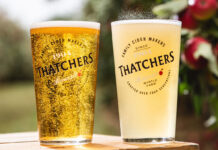Stocking a blend of big brands and small-batch spirits is key
As image makeovers go, gin’s has been pretty impressive.
Once saddled with the less-than-complimentary ‘Mothers’ Ruin’ moniker, the spirit is now considered one of the ‘in’ drinks, making it big business for pubs and bars.

That a huge number of craft and small-batch gins – many of which are Scottish – have emerged in recent years is only said to have fuelled consumer interest in the category.
And producers say it’s younger consumers in particular who are driving growth in the sector – a trend with which market research firm Mintel concurred.
Will Holt of Pinkster Gin said the category is in rude health – and he is confident it will “continue to flourish” this year. “For operators, this means continued sales opportunities as the gin renaissance gathers momentum,” he said.
“The Mintel report backed up all our intelligence from bars, pubs and clubs that younger drinkers are helping fuel the gin revival. We attribute this to the explosion of new brands, new flavours and new serves.
“The category is on fire and consumers are reaping the benefits of quirky brands offering something a little different.”
The buoyancy of the gin category was underlined by Paul Donegan, Scottish brand ambassador for Pickering’s, which is produced at Summerhall Distillery in Edinburgh, who said the sector is going “from strength to strength”.
“Scotland is producing gin now to a similar standard to its whisky, which can only be a good thing for the category as a whole,” he said.
“You can now get locally-produced, small-batch gin literally from the Borders to the Outer Hebrides and they are all distinctive and produced in every way it is possible to produce gin.”
So far, so good.
But with such a burgeoning category spanning big brands to small-batch spirits and everything in between where do operators begin when it comes to deciding which gins to stock?
Renaud de Bosredon, Bombay Sapphire’s UK brand ambassador, said there are three basic rules to follow when selecting a range.
“One, what is the most popular gin in the outlet; two, what gin do the staff like to work with; and three, what the operator believes to be a good quality gin for the guest,” he said.
“A strong base of London Dry gin is always a good start and to make sure to have a selection of styles, including vapour infusion, Old Tom, Navy and some lighter style of flavour to introduce gin to consumers [who are] new to the category.”
Quality over quantity was the ranging advice from Mike Hayward of Makar Glasgow Gin. Advocating a balanced range which combines “big brand names with small-batch and local brands”, Hayward said stocking spirits of a high standard should be the overarching aim.


“Drinking habits have changed over the years and consumers are now going out on fewer occasions however they are seeking out a more premium and special experience on those occasions when they do go out – this should be reflected in the range of gins stocked,” he said.
That advice was echoed by Vivienne Muir of North Berwick-based NB Gin, who said demand for premium gin is growing as consumers become increasingly discerning.
“Given the resurgence of the gin market there is now greater choice, but operators shouldn’t have a ‘select all’ approach or stock something just because it’s new or looks good on the shelf,” she said.
“They should select on quality and endorse the brands they would personally approve of themselves.”
Dan Bolton, managing director of Hi-Spirits, whose gin portfolio includes Blackwoods and Langleys No 8, agreed, saying gin is “no longer a ‘one-size-fits-all’ spirit category”.
“Stocking a range of brands covering mainstream, premium, local and craft gins will interest and engage consumers; and with each gin having its own flavour profile, a suggested serve cocktail for each brand will drive sales,” said Bolton.
Provenance is another important consideration when choosing which gins to stock, according to Scott McKenzie, national sales manager at Eden Mill, which produces a range of gins including Love Gin and Oak Gin.
Agreeing that the category is “going from strength to strength”, McKenzie said consumers are “willing to trade up for a premium offering”.
“The Scottish craft distillation movement is thriving so I would begin the search there – the botanicals that are used then determines the type of tonic,” he said. “For example, Eden Mill Love Gin is floral and subtle so Fever-Tree Mediterranean Tonic, which is softer, works really well garnished with grapefruit and mint.
“There is certainly a greater awareness of botanicals but, ultimately, I think the important thing is does it make a good G&T?
“When it comes to provenance, with Eden Mill we have the St Andrews connection, but ultimately that means nothing if we don’t make good product so it can only take you so far.”
The importance of quality was underlined by Alex Nicol of Spencerfield Spirit Company – the firm behind Edinburgh Gin.
“Operators should stock quality craft gins and keep an eye out for any new innovative gins,” he said.
“The success of our seasonal craft gins – Valentine’s Gin, Seaside Gin and Christmas Gin – shows that there is an appetite for unique, innovative gins with unusual botanicals and flavours. Having a premium range of tonics and mixers is important as we have found that people like different mixers for their gins.”
Interest in premium and flavoured tonics is said to have grown in tandem with the craft gin sector.
Luke Benson, head of on-trade marketing at Fever-Tree, said the “continuous boom” in small-batch gins has “influenced the mixer market hugely”. And he reckons, when it comes to tonic, there’s something to suit all palates.
“Our tonics work well when partnered with all kinds of different gins which use different botanicals and we’ve put a lot of time into sourcing the ingredients for the flavours of each tonic to fully showcase this,” he said.
“We offer all bars, pubs and restaurants a bespoke gin and tonic pairing menu which is built to showcase the huge variance in flavour offerings across gin and, indeed, our tonic range.”
However, range – of gins or tonics – counts for nothing if bars don’t consistently deliver a quality serve.
Tanqueray brand ambassador Tim Homewood said: “Customers are becoming increasingly discerning with what they’re drinking – paying more attention to the overall presentation and serve. Therefore operators should be stocking the appropriate glassware and using fresh garnishing to ensure they’re going beyond the standard ‘ice and slice’ serve.”
That advice was echoed by Faith Holland, head of on-trade category development at Gordon’s owner Diageo. “Gin and tonic remains the most popular gin serve; but we have seen it reinvented and reimagined with new premium and flavoured tonic waters, served in different glassware, such as Spanish Copa glasses, and with different garnishes, such as grapefruit, peppercorns and fresh herbs,” she said.
Martin Murray of Rock Rose gin underlined the importance of delivering a quality serve.
“We always advise on our perfect serves, but we encourage licensees to experiment with tonics and garnishes,” he said. “Consumers are keen to try new combinations and the choice of tonics and garnishes can set you apart from the crowd.”
Emma Hooper, of Darnley’s View gin, agreed, saying gin drinkers are a “curious audience looking for new flavour profiles”.
“The classics will be forever popular but stocking a variety of gin styles and flavour profiles ensures you are catering for every palate,” said Hooper.
Ice is another important factor in delivering the ‘perfect’ gin serve.
Bob Fowkes, co-founder and marketing director of Brockman’s Gin, advised bar operators to “rethink the size quality of ice”.
“The gin and tonic boom in Spain provides useful lessons on how to serve mixed drinks perfectly,” he said.
“Key to that is to ensure that the ice cubes do not dilute your drink in the first five minutes after serving.”
The importance of quality, coupled with myriad mixer and garnish combinations not to mention the raft of craft gins – each with its own back-story – to get to grips with means staff training is crucial.
Caorunn brand ambassador Sian Buchan said bartenders are “excited about the range and nuances of botanicals and flavours within gins, which is in turn exciting drinkers”.
“People are asking many more questions about what’s in the gin, where it’s from and how it’s made; it’s wonderful,” she said.

























